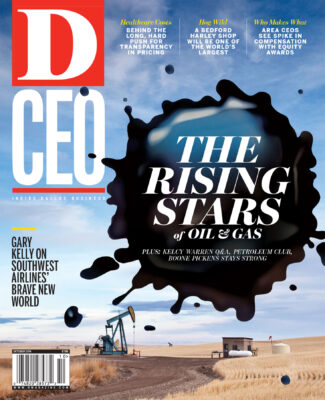If CEOs of midsize companies in North Texas had to pick a theme song for their compensation results in 2013, their best choice might be “Happy” by Pharrell Williams. That’s because their median overall total pay last year nearly went up by double digits.
| Rank | Company Name | Executive Name | Reported Salary | Total Cash (Base + Bonds) | Total Long-Term Incentives | Total Reported Compensation |
|---|---|---|---|---|---|---|
| 1. | Tyler Technologies | John S. Marr Jr. | $469,000 | $1,055,250 | $7,772,109 | $8,827,359 |
| 2. | Athlon Energy | Robert C. Reeves | $470,000 | $1,325,000 | $5,345,595 | $6,670,595 |
| 3. | Ashford Hospitality Trust | Montgomery J. Bennett | $800,000 | $2,400,000 | $3,981,934 | $6,381,934 |
| 4. | CyrusOne | Gary J. Wojtaszek | $600,000 | $1,502,922 | $4,787,548 | $6,290,470 |
| 5. | Texas Capital Bancshares | George F. Jones Jr. | $703,333 | $1,380,133 | $3,960,692 | $5,340,825 |
| 6. | FelCor Lodging Trust | Richard A. Smith | $742,630 | $1,819,779 | $2,716,710 | $4,536,489 |
| 7. | Diodes | Keh-Shew Lu | $482,958 | $1,242,958 | $2,898,400 | $4,141,358 |
| 8. | Exco Resources | Douglas H. Miller | $1,250,000 | $1,250,000 | $2,863,285 | $4,113,285 |
| 9. | Howard Hughes Corp | David R. Weinreb | $1,000,000 | $4,000,000 | $0 | $4,000,000 |
| 10. | Eagle Materials | Steven R. Rowley | $860,000 | $1,340,000 | $2,600,000 | $3,940,000 |
| 11. | Capital Senior Living | Lawrence A. Cohen | $704,109 | $1,472,925 | $2,407,000 | $3,879,925 |
| 12. | Westwood Holdings | Brian O. Casey | $600,000 | $2,103,328 | $1,396,500 | $3,499,828 |
| 13. | Realpage | Stephen T. Winn | $500,000 | $535,000 | $2,647,900 | $3,182,900 |
| 14. | Nl Industries | Steven L. Watson | $3,105,000 | $3,105,000 | $29,560 | $3,134,560 |
| 15. | Greatbatch | Thomas J. Hook | $700,000 | $1,208,097 | $1,833,341 | $3,041,438 |
| 16. | Capstead Mortgage | Andrew F. Jacobs | $720,000 | $1,453,500 | $1,407,829 | $2,861,329 |
| 17. | Nexstar Broadcasting Group | Perry A. Sook | $1,191,539 | $2,791,539 | $0 | $2,791,539 |
| 18. | Sizmek | Neil H. Nguyen | $624,750 | $1,157,350 | $1,443,781 | $2,601,131 |
| 19. | Approach Resources | J. Ross Craft | $525,000 | $1,169,070 | $1,423,530 | $2,592,600 |
| 20. | HMS Holdings | William C. Lucia | $650,000 | $650,000 | $1,874,988 | $2,524,988 |
| 21. | Matador Resources | Joseph Wm. Foran | $600,000 | $1,200,000 | $981,150 | $2,181,150 |
| 22. | Fiesta Restaurant Group | Timothy P. Taft | $525,000 | $951,720 | $1,218,905 | $2,170,625 |
| 23. | PFSweb | Michael C. Willoughby | $422,985 | $800,435 | $1,339,398 | $2,139,833 |
| 24. | Comstock Resources | M. Jay Allison | $802,000 | $1,902,000 | $0 | $1,902,000 |
| 25. | U S Lime & Minerals | Timothy W. Byrne | $390,000 | $1,005,000 | $711,450 | $1,716,450 |
| 26. | AZZ | Thomas E. Ferguson | $478,077 | $817,053 | $796,352 | $1,613,405 |
| 27. | ClubCorp | Eric L. Affeldt | $500,000 | $1,550,000 | $0 | $1,550,000 |
| 28. | First Cash Financial Services | Rick L. Wessel | $963,040 | $1,444,560 | $0 | $1,444,560 |
| 29. | A.H. Belo | James M. Moroney | $558,462 | $1,098,996 | $322,872 | $1,421,868 |
| 30. | U.S. Concrete | William J. Sandbrook | $761,885 | $1,407,119 | $0 | $1,407,119 |
| 31. | Atrion Corp. | David A. Battat | $450,000 | $1,350,000 | $0 | $1,350,000 |
| 32. | Global Power Equipment Group | Luis M. Ramírez | $550,000 | $638,000 | $705,973 | $1,343,973 |
| 33. | Holly Energy Partners | Matthew P. Clifton | $250,000 | $250,000 | $1,075,035 | $1,325,035 |
| 34. | Del Frisco’s Restaurant Group | Mark S. Mednansky | $400,000 | $400,000 | $843,580 | $1,243,580 |
| 35. | Affirmative Insurance | Michael J. Mcclure | $650,000 | $1,200,000 | $30,300 | $1,230,300 |
| 36. | Texas Industries | Mel G. Brekhus | $593,077 | $647,640 | $557,900 | $1,205,540 |
| 37. | Speed Commerce | Richard S Willis | $350,000 | $450,000 | $617,540 | $1,067,540 |
| 38. | Hallwood Group | Anthony J. Gumbiner | $996,000 | $996,000 | $0 | $996,000 |
| 39. | CompX International | David A. Bowers | $448,951 | $898,951 | $0 | $898,951 |
| 40. | Cambium Learning Group | John Campbell | $375,000 | $630,000 | $206,082 | $836,082 |
| 41. | SWS Group | James H. Ross | $450,000 | $550,000 | $250,000 | $800,000 |
| 42. | TGC Industries | Wayne A. Whitener | $350,000 | $550,000 | $242,400 | $792,400 |
| 43. | PMFG | Peter J. Burlage | $375,000 | $421,275 | $262,497 | $683,772 |
| 44. | OmniAmerican Bancorp | Tim Carter | $450,012 | $575,312 | $0 | $575,312 |
| 45. | Hallmark Financial Services | Mark J. Morrison | $400,000 | $400,000 | $156,639 | $556,639 |
| 46. | Natural Health Trends | Chris T. Sharng | $403,846 | $548,077 | $0 | $548,077 |
| 47. | DGSE Companies | James J. Vierling | $535,000 | $535,000 | $0 | $535,000 |
| 48. | Quicksilver Resources | Glenn Darden | $455,000 | $455,000 | $0 | $455,000 |
| 49. | Tandy Leather Factory | Jon Thompson | $218,000 | $413,000 | $0 | $413,000 |
| 50. | Dorchester Minerals | William C. McManemin | $96,000 | $96,000 | $0 | $96,000 |
What a difference five years makes. When we initiated our annual executive compensation study back in 2009, CEO pay had taken a nosedive in response to the economic recession. Many companies had frozen base pay for chief executives; 41 percent awarded no bonuses; and 40 percent made no long-term incentive award (e.g., equity awards such as stock options or restricted stock). In 2009, median total direct compensation (base salary plus bonuses and long-term incentive award value) for the Dallas-Fort Worth Midsize Group CEOs was just $714,101. We also learned that midsize companies in DFW were, in fact, more conservative than bigger companies or their midsize counterparts on either coast in managing CEO pay during the height of the recession. Today, though, with economic recovery in full bloom—especially in Texas—and both shareholder and competitive pressures looming, how have the conservative ways of local midsize companies fared?
In this article, D CEO, assisted by Paradox Compensation Advisors, a Dallas-based compensation consulting firm, presents the results of our fifth annual study of CEO compensation among midsize companies in North Texas. This year’s findings, in a nutshell, are that local companies are no longer shy about rewarding their CEOs with significant incentives in the form of bonuses and equity awards. Increasingly, though, “strings” in the form of performance criteria (even for equity awards) are attached.
This year’s DFW midsize company group was selected based on 2013 total revenue between $50 million and $1 billion. Further, the company’s CEO had to be in place for the full year, or sufficient information had to be provided regarding his or her employment agreement to project full year pay. In total, data from proxy statements for 50 companies was analyzed and included in the study. Last year, we reported that both median annual revenue and net income had been flat. But in 2013, median net income rose 12 percent and revenue grew by 11 percent. At the same time, the median overall total compensation increase for CEOs (again, base salary, annual bonuses, and long-term incentives) was 9 percent—the largest increase in the pay study’s five years.
The median value of total compensation in 2013 for midsize group CEOs was $1,809,225. Thus, the typical midsize company has more than doubled CEO pay since 2009. Of course, there are wide variations among companies, and the composition of the CEO group has changed over time. Looking at the 42 CEOs who were in the same job in both 2012 and 2013, the increase in total compensation was also 9 percent. However, 25 percent of the group lost more than 23 percent of pay versus last year, while 25 percent gained more than 45 percent in pay from 2012 to 2013.
The accompanying chart, titled “CEO Compensation—DFW Midsize Companies,” ranks CEOs based on total compensation for all 50 companies and also reports base salary, total annual cash incentives, and total long-term incentives. From top to bottom, total 2013 compensation ranges from $8,827,359 for Tyler Technologies’ John S. Marr Jr. to $96,000 for Dorchester Minerals’ William McManemin.
Noticeable upward changes in ranking include: Tyler Technologies’ John S. Marr Jr. (20th to first place); FelCor Lodging’s Richard Smith (25th to sixth); and Texas Capital Bancshares’ George Jones (26th to fifth). Major downward changes in rank occurred for Nexstar’s Perry Sook (first to 17th); First Cash Financial’s Rick L. Wessel (second to 28th); Comstock Resources’ M. Jay Allison (third to 24th); Atrion’s David A. Battat (seventh to 31st); and Quicksilver Resources’ Glenn Darden (eighth to 48th). In all of these cases, the reason behind the swing was a long-term incentive award. CEOs rising significantly in rank received an award that was substantially higher than last year’s, or they did not receive an award last year. None of the CEOs falling in rank received an award in 2013.
HIGH REWARDS FOR CEOS
In the 2012 study, CEOs at just four companies received year-over-year total compensation increases of greater than 50 percent. In 2013, this number jumped to 10 companies, or almost 20 percent of all CEOs. However, Paradox Senior Partner Marsha Cameron explains that a number of these apparent increases are linked to equity awards that will be significantly less valuable (or even worthless) unless the company meets objective financial goals. “In contrast to what we observed five years ago,” Cameron says, “a number of DFW midsize companies have jumped on the trend of more sophisticated equity award design, which provides high rewards for CEOs only when key performance objectives are met.” She notes several examples demonstrating this point:
• Athlon Energy. The company made no equity award to its CEO in 2012. Then, half of the equity award made in 2013 was subject to “performance-based vesting.” So, the actual number of shares earned by the CEO will vary from zero to 200 percent of the initial award, depending on how the company’s total returns to shareholders compare to industry peers.
• Capital Senior Living. Shares awarded are subject to forfeiture or reduction depending upon “EBITDAR” (income from operations before income taxes, interest, depreciation and amortization, facility lease expense, non-cash compensation expense, and provision for bad debt). In fact, in 2013 because 97.1 percent of target EBITDAR was achieved, some shares were forfeited.
• FelCor Lodging. No grants were made in 2012. But starting in 2013, the company is awarding stock units that allow the CEO to earn shares of common stock based on relative total shareholder returns achieved over multiple years. Again, the actual number of shares earned is scaled (zero to 200 percent) depending on the company’s performance versus peers.
Clearly, major increases in total compensation have been fueled by equity and other long-term incentive awards. Given the conservative use of long-term incentives among North Texas midsize companies observed five years ago, Paradox chose to analyze the degree to which pay programs have changed. The pie charts on page 65 depict what happened to “mix” of pay (i.e., base salary versus annual and longer-term incentives as a proportion of total compensation) between 2009 and 2013 for companies included in this year’s study.
In 2009, base salary accounted for more than 50 percent of the average CEO’s pay package in middle market companies. Long-term incentives (LTI on the charts) accounted for 29 percent. The split between base salary and combined annual and longer-term incentives was 52 percent salary and 48 percent incentives.
By 2013, however, the split between base salary and total incentives as a percent of the average CEO’s pay package had shifted to 40 percent/60 percent. The biggest factor in this shift is the increase in the value of long-term incentives, growing from 29 percent in 2009 to 37 percent in 2013.
Average mix of pay shifted substantially, despite the fact that there continues to be wide variation in the use of long-term incentives among middle market companies. Interestingly, the median grant in 2013, $708,712, was almost as large as total compensation for middle market CEOs in the 2009 study ($714,101). Most North Texas midsize companies are tying more and more CEO compensation to long-term incentives and, specifically, to the opportunity to earn equity. Companies making no long-term incentive grants or infrequent grants will find themselves getting further behind competitively, according to Cameron, given practices increasingly pursued by the majority of the group.
Historically, stock options have been the equity vehicle of choice. In 2013, of the 36 companies making long-term incentive awards to the CEO, only four awarded stock options as their sole vehicle. In the case of stock options, the executive will ultimately benefit from appreciation above the stock price on the date of grant. Nineteen companies awarded restricted stock or units, sometimes referred to as “full value awards,” because, once vested, the executive will earn the full value of the shares, not just the appreciation. Four companies granted both stock options and restricted stock. The rest granted other types of long-term incentives. North Texas companies are far more willing to offer multiple types of awards and full value awards than they were five years ago.
ANNUAL CASH INCENTIVES
With significant increases to revenue (11 percent) and net income (12 percent), we would not be surprised to see an increase in annual bonus payments. This year’s study found a median bonus of $480,760, which is a 3 percent increase over CEO bonuses among these same companies in 2012. Again, there was a wide range in bonus trends for the CEO, with 25 percent of companies decreasing bonuses by 21 percent or more, while 25 percent increased bonuses by 40 percent or more.
We would expect to see bonus reductions associated with less than satisfactory performance, and increases related to high performance. In fact, seven companies with net income declines increased bonuses for their CEOs. These companies included Cambium Learning Group, Capital Senior Living, Capstead Mortgage, CyrusOne, PFSWeb, Speed Commerce, and ClubCorp. Many companies explain the rationale for bonus awards in public disclosures. For CyrusOne, PFSWeb, Capital Senior Living, and ClubCorp, objectives on metrics used to determine bonuses, including EBITDA and/or revenue, were achieved despite declining net income. In the case of Capstead Mortgage, the bonus award was based on favorable performance relative to other mortgage REITs. On the other hand, when Speed Commerce did not achieve EBITDA targets, the company still awarded a discretionary bonus.
The largest bonus increases were awarded for CEOs at Athlon Energy, Howard Hughes, PFSWeb, and ClubCorp, the last three of which exceeded certain goals set for 2013. A significant portion of the Athlon increase was attributable to a special one-time bonus to reward efforts associated with its initial public offering. Increasingly, middle market companies are using more formulaic approaches to determine bonus payouts. Of the 30 companies paying bonuses in 2013, half determined these payouts under an explicit formula. The other half may use performance metrics to guide payouts, but use more discretion in determining the precise amount. Though middle market companies are still more likely than larger companies to make discretionary decisions about bonuses, the clear trend over the past five years has been to move toward greater objectivity.
Where CEO base salaries are concerned, the median for the full group was $530,000 versus a median of $520,000 in 2012 for the same companies. In the 42 companies where the same incumbent was in place in both 2013 and 2012, 26 companies increased base salary in 2012 while 16 maintained the same base salary. The median base salary increase was 4 percent. The largest percentage increases were awarded to CEOs at Holly Energy, Speed Commerce, Athlon Energy, DGSE Cos., Global Power Equipment, Greatbatch, and Exco Resources.
As stated in prior studies, the top three factors influencing executive pay are company size, financial results, and industry. The bar chart on page 64 shows median total compensation by industry. This year, the top three paying industries included hospitality, technology, and health services. Oil and gas slipped from third to fifth in 2013.
WHAT THE FUTURE HOLDS
If recent history is any indication, Cameron predicts that, as long as the economy continues to improve, area midsize companies will continue to enhance CEO pay levels and add compensation program structure consistent with trends being fueled by shareholder pressure and regulatory disclosure. We also can expect the use of equity to continue to expand and become more sophisticated, aligning even more closely with longer-term business objectives.






